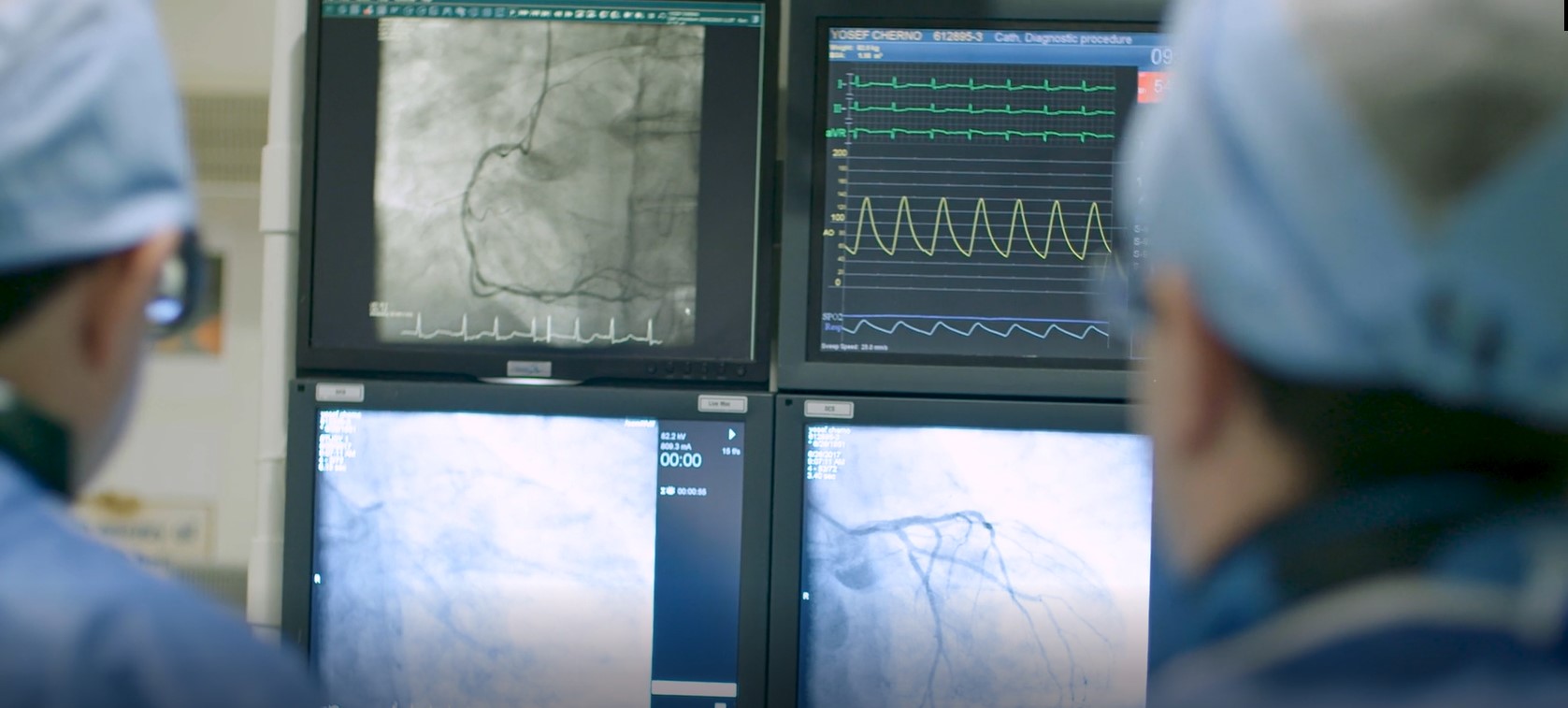Vascular Services
Evaluate, diagnose and
treat
Our surgeons perform more than 500 vascular surgeries
annually.
Cookeville Regional Medical Center’s Heart and Vascular Center’s team of board-certified vascular surgeons are renowned leaders in vascular surgery and minimally invasive endovascular therapy.
Our team provides comprehensive state-of-the-art diagnostic and therapeutic interventions for the entire spectrum of circulatory disorders.
Vascular surgery is a surgical subspecialty in which diseases of the vascular system, or arteries, veins and lymphatic circulation, are managed by medical therapy, minimally-invasive catheter procedures and surgical reconstruction.
With a dedicated angiography suite and a full range of other imaging procedures available, our vascular specialists are able to evaluate, diagnose and treat a wide range of vascular disorders.
We have non-invasive CT/ultrasound/MRI studies to work up for possible intervention. We have more than 75 percent interventions per year.
In 2021, there were more than 800 patients who utilized the vascular lab. Fifty-five percent were outpatient, 45 percent were in-patient.

What We Treat
- Aortic Aneurysm – EVAR, TEVAR
- Carotid Artery Disease – TCAR
- Peripheral Arterial Disease
- Embolization coils/beads
- Athrectomy
- Venous clot removal/lysis
- Shockwave
- Aspira drain catheter-ascites
EKOS Endovascular System
Cookeville Regional has innovative technology that helps dissolve blood clots in lungs and elsewhere. The EKOS Endovascular System has been shown to be very effective in removing clots and improving patient outcomes.
The cardiologists are able to place a catheter inside the lungs that dispenses a clot-busting medication right there where the clot is instead of administering an IV or taken it by mouth where it affects the entire body.
This also produces ultrasound waves to further dislodge and break apart the clot to help dissolve it.
PROCEDURES
Transcarotid Artery Revascularization (TCAR)
TCAR may be recommended if:
- You’ve been diagnosed with carotid artery disease that requires intervention, and
- Your age, anatomy or other medical conditions place you at high risk for open surgery (carotid endarterectomy).
How it’s done:
The TCAR procedure takes place in an operating room. Local or general anesthesia may be used – your surgeon will determine what is best for you.
- The procedure is performed through a small incision at your neckline just above your clavicle.
- Your surgeon will place a tube directly into your carotid artery and connect it to a system that will direct blood flow away from your brain, to prevent any loose plaque from reaching your brain.
- Your blood will flow through the system and any material will be captured in a filter outside the body.
- Your filtered blood will then be returned through a second tube in your upper leg.
- A carotid stent is then placed to stabilize the plaque in your carotid arteries. After successful placement, flow reversal is turned off and blood flow resumes in its normal direction.
Risks:
While any intervention of the carotid artery carries some risk of causing a stroke because of the procedure itself, TCAR was designed to help minimize that risk. Potential risks of TCAR include:
- Stroke, heart attack or death
- Damage to your carotid artery or cranial nerve
- Bleeding, bruising or swelling at the access site in your neck
Watch this video on how a TCAR is performed in this presentation by Silk Road Medical:
Cookeville Regional’s team reaches milestone:
PROCEDURES
Angiography
An angiogram is a study that assesses blood vessels, either arteries or veins, for abnormalities such as narrowing or blockage. These abnormalities can be caused by conditions like atherosclerosis and hardening of the arteries. For this study, liquid contrast dye is injected into the vessels to make them visible on X-ray images. The images are obtained as the dye passes through the vessels. The physician evaluates the images to determine the type and extent of any blockage or narrowing in the vessels. He or she will also determine if the abnormality would be best treated by angioplasty and/or stenting, or by medical or conventional surgical treatment. This decision is based on the appearance and location of the narrowing or blockage on the angiogram, and your overall medical condition. Angioplasty and stenting can often be performed at the same time as the diagnostic angiogram.
Angioplasty is a way to treat segments of a blood vessel that have become narrowed from conditions such as atherosclerosis and hardening of the arteries. This type of treatment can lead to significant improvement in symptoms. For instance, it can improve leg pain associated with exercise. It can also cause dramatic improvement in the function of organs such as the kidney. This procedure usually follows a diagnostic angiogram, if that study shows a potentially treatable blockage or narrowing. In the procedure, the physician inflates a small balloon in the blood vessel at the site of narrowing to push back the wall along with any plaque or clot. This opens up the vessel to allow more blood to pass through. Sometimes a permanent metallic scaffold is placed at the site of narrowing after angioplasty has opened it up. This is called a stent. The stent works by pushing against the vessel wall to hold it open from the inside. Angioplasty and stenting can be performed directly after a diagnostic angiogram if the physician determines that these interventions would be beneficial.
DURING THE EXAM
This exam is performed in a hospital setting with specialized equipment and a team of highly skilled nurses and technologists. You will first be asked to change into a gown and lie on the fluoroscopy table. The radiologist will then find an appropriate blood vessel in which to start the study. This starting site is most often in the groin area or arm, and may be a distance away from the blood vessel of concern. The skin above the starting vessel is numbed with an anesthetic. You may also receive conscious sedation to make you sleepy and relaxed. After the skin is numbed, a small needle is used to guide a catheter through the skin into the blood vessel. The catheter is advanced through the blood vessels of the body to the area of concern. A diagnostic angiogram may have been done previously, which determined that there is a treatable narrowing or blockage. Otherwise, the angiogram is done at this time, and if there is an abnormality, angioplasty is performed. For the angioplasty, a deflated balloon is passed through the catheter into the narrowed or blocked segment of the blood vessel. The balloon is then inflated under controlled conditions to open up the segment. It is common to experience a brief moment of pressure or pain during angioplasty or stenting since the vessel wall is being stressed. This sensation nearly always subsides following deflation of the balloon. After the balloon is deflated, it is removed from the body. If a metallic scaffold or stent is to be placed, it is advanced in its closed form to the site the same way as the balloon, and then opened up against the vessel wall. The stent is permanent and cannot be ordinarily removed following its placement. After the procedure, the catheter is removed and pressure is applied at the skin entry site to stop any bleeding. You will most likely be sent home the same day of your angioplasty or stenting, after being monitored for a few hours following the procedure.
PREPARATION FOR THE EXAM
You may continue your usual activities the day before the exam. Depending on the time of the scheduled procedure, you may be asked to not eat or drink anything for breakfast on the day of the procedure. If you take medication to thin the blood (anticoagulants), you may be asked to refrain from taking that medication for a period of time (depending on the medication) prior to the procedure.
HOW WILL I GET MY RESULTS?
The surgeon will dictate a report and your physician should present the findings of your exam to you and your family. You may also sign up for a patient portal account as mycrmchealth.org to read your results online.
PROCEDURES
Inferior Vena Cava placement
The blood that circulates through our bodies has many functions, one of which is to bring oxygen to all the cells of the body. The blood passes through the lungs in order to get the oxygen. Anything that blocks the blood from going through the lungs will prevent the blood from getting oxygen. This could starve the cells of the body for oxygen and be potentially life threatening. The blood can be blocked from getting to the lungs if blood clots lodge in the vessels leading into the lungs. These blood clots are called pulmonary emboli (a single clot is called a pulmonary embolism). They typically form in the veins of the pelvis and legs. Many conditions can lead to the formation of these blood clots. These conditions include recent surgery, lack of mobility, and recently giving birth. The clots can break off in the vein where they form and then travel with the venous blood back through the heart and into the lungs. In doing so, they pass through the inferior vena cava, which is a large vein that returns the blood from the pelvis and legs back to the heart and lungs. If the clots can be stopped in the inferior vena cava before they get to the lungs, they can be held there until the body is able to break them down and dissolve them. This is what the inferior vena cava filter does. The filter traps the clots in a metal mesh that acts like a sieve or colander. The blood is allowed to pass through the mesh and get to the lungs, but the clots get stuck. In time, the body dissolves the clots in the mesh, so that they never make it to the lungs. Of note, there are also medications that can speed the breakdown of blood clots. These medications avoid the need for the filter, but they can have serious side effects, and not everyone will benefit from their use. In such situations, a physician can place an inferior vena cava filter, which is the best treatment for the clots.
DURING THE EXAM
This exam is performed in a hospital setting with specialized equipment and a team of highly skilled nurses and technologists. You will first be asked to change into a gown and lie on the fluoroscopy table. The radiologist will then find an appropriate vein in which to start the study. This starting site is most often in the groin area, neck or arm, and may be a distance away from the inferior vena cava. The skin above the starting vein is numbed with an anesthetic. You may also receive conscious sedation to make you sleepy and relaxed. After the skin is numbed, a small needle is used to guide a catheter through the skin into the vein. The catheter is advanced through the veins of the body to the inferior vena cava. A diagnostic angiogram is done at this time. The X-ray contrast dye may make you feel warm for a very brief period of time after the injection, but the feeling passes quickly. X-ray images are obtained and reviewed by the radiologist to make sure the filter is not placed in or below any clot. The filter is then advanced in its closed form through the catheter and opened at the appropriate site in the inferior vena cava. The filter is permanent and cannot be ordinarily removed following its placement. After the procedure, the catheter is removed, leaving the filter behind, and pressure is applied at the skin entry site to stop any bleeding. If you have this procedure as an outpatient, you will most likely be sent home the same day of your filter placement, after being monitored for a few hours following the procedure.
PREPARATION FOR THE EXAM
IVC filters are placed in both outpatients and inpatients who are admitted to the hospital. For outpatients, you may continue your usual activities the day before the exam. Depending on the time of the scheduled procedure, you may be asked to not eat or drink anything for breakfast on the day of the procedure. If you take medication to thin the blood (anticoagulants), you may be asked to refrain from taking that medication for a period of time (depending on the medication) prior to the procedure.
PROCEDURES
Nephrostomy Tube and Ureteral Stent
The urinary tract is a system of ducts in the kidney connected to a tube called the ureter that extends from the kidney down to the bladder. This system allows urine to get from the kidneys to the bladder. It can become blocked by kidney stones, tumors, blood clot or other debris. If the system is blocked and urine cannot drain normally, it backs up in the kidney and can cause infection and/or damage to the kidney function. In such cases, a radiologist can place a catheter, called a nephrostomy tube, directly through the skin of the back, through the kidney, and into the urine collecting system in the middle of the kidney. The urine can then drain through the catheter to the outside, which prevents any damage or infection to the kidney. A catheter can also be extended down through the kidney into the ureter and past any blockage, allowing the urine to pass into the bladder. This second type of catheter is called a ureteral stent. Both types of catheters can be left in place for up to three months at a time. They can then be exchanged for new ones as long as is needed, until the blockage is removed, bypassed surgically, or resolves on its own.
DURING THE EXAM
This procedure is performed in a hospital setting with specialized equipment and a team of highly skilled nurses and technologists. You will be asked to change into a gown and lie face down on the fluoroscopy table. The radiologist will use the imaging equipment to find your kidney. The skin above the kidney is numbed with an anesthetic. You may also receive conscious sedation to make you sleepy and relaxed. After the skin is numbed, a small needle is pushed through the skin down to the kidney using X-ray or ultrasound guidance. A catheter is then guided down this tract to the kidney. This catheter is the nephrostomy tube. After its position in the kidney is confirmed, it is stitched in place at the skin surface and connected to a bag to collect the urine. To place a ureteral stent, the radiologist first gets into the kidney as if for a nephrostomy tube, then he or she advances a catheter down from the kidney into the bladder under direct X-ray guidance. There are various types of ureteral stents available, some in which a portion of the catheter sticks out through skin like a nephrostomy tube, and others in which the catheter is completely internalized. The type of catheter chosen is based on your particular situation and needs. You will most likely be sent home the same day of your nephrostomy tube or ureteral stent placement, after being monitored for a few hours following the procedure.
PREPARATION FOR THE EXAM
You may continue your usual activities the day before the exam. Depending on the time of the scheduled procedure, you may be asked to not eat or drink anything for breakfast on the day of the procedure. If you take medication to thin the blood (anticoagulants), you may be asked to refrain from taking that medication for a period of time (depending on the medication) prior to the procedure.
HOW WILL I GET MY RESULTS?
The radiologist will dictate a report, which will then be sent to the ordering physician. You may also sign up for a patient portal account at mycrmchealth.org to read your results online.
PROCEDURES
Thrombolysis and Thombectomy
Blood clots can develop in arteries and veins for a variety of reasons. These include recent surgery, infection, immobility and vascular disease such as is found in diabetes. The clots can slow down or cut off the blood supply to an organ or extremity, causing worsening function in the organ, or pain and swelling in the extremity. If the clots are severe enough, they can cause loss of the organ or extremity, with potentially life-threatening consequences. Thrombolysis is a method of dissolving blood clots using various medications administered directly into the blood vessel at the site of the clot. Thrombectomy is the disruption of a blood clot using various mechanical devices. A physician can use either or both of these methods to dissolve and remove blood clots, resulting in an increase of blood flow to the affected area and an improvement in function and symptoms.
DURING THE EXAM
This exam is performed in a hospital setting with specialized equipment and a team of highly skilled nurses and technologists. You will first be asked to change into a gown and lie on the fluoroscopy table. The physician will then find an appropriate blood vessel in which to start the study. This starting site is most often in the groin area or arm and may be a distance away from the blood vessel of concern. The skin above the starting vessel is numbed with an anesthetic. You may also receive conscious sedation to make you sleepy and relaxed. After the skin is numbed, a small needle is used to guide a catheter through the skin into the blood vessel. The catheter is advanced through the blood vessels of the body to the vessel that has the clot, and contrast dye is infused through the catheter to visualize the clot and surrounding vessels. The contrast agent may make you feel warm for a very brief period of time after the infusion, but the feeling passes quickly. X-ray images are obtained during the infusion. The physician will review the images to determine whether the clot would be best treated by directly administering the thrombolysis medication into the clot or by disrupting the clot with thrombectomy devices. For thrombolysis, the catheter is left in place, and the medications are infused through the catheter over several hours to several days. You will be admitted to the hospital for the duration of the infusion. Thrombectomy, if performed, may also be followed by thrombolysis. In both methods, follow-up contrast dye infusions are performed to make sure the vessel remains free of clot. The catheter is then removed after the treatment is complete, and pressure is applied at the skin entry site to stop any bleeding.
PREPARATION FOR THE EXAM
You may continue your usual activities the day before the exam. Depending on the time of the scheduled procedure, you may be asked to not eat or drink anything for breakfast on the day of the procedure or sometimes not eat or drink since midnight before the procedure. If you take medication to thin the blood (anticoagulants), you may possibly be asked to refrain from taking that medication for a period of time (depending on the medication) prior to the procedure.
PROCEDURES
Peripherially Inserted Central Venous Catheter
Some types of medical treatments, such as high dose antibiotic therapy, dialysis and chemotherapy, require frequent blood draws and long-term infusions of intravenous medications. Frequent attempts to get blood from the veins in the arms, along with the caustic effect of some of the medications, can be painful and damaging to the veins. For this reason, PICC lines can be placed by a technologist into the large central veins of the upper arm or chest. These lines allow a short-term or long-term means of obtaining any number of blood samples without repeatedly sticking a needle into the arm. They also allow infusion of intravenous medications into veins that are large enough to dilute the medication immediately, so that it does not damage the vein. There are many types of lines available that differ based on function and amount of time they can be left in place, which can vary from weeks to years. The type of line chosen is determined by the specific needs of the individual patient.
DURING THE EXAM
This exam is performed in a hospital setting with specialized equipment and a team of highly skilled nurses and technologists. You will first be asked to change into a gown and lie on the fluoroscopy table. The technologist will then find an appropriate vein in the arm in which to place the catheter. The skin above the vein is numbed with an anesthetic. After the skin is numbed, a small needle is used to guide a catheter through the skin into the vein. The position of the catheter is confirmed, and then it is anchored in place at the skin surface with an adhesive device called a StatLock. Many of the catheters require some basic home care, which will be explained to you at the time of the catheter placement. You will likely go home the same day the catheter was placed.




